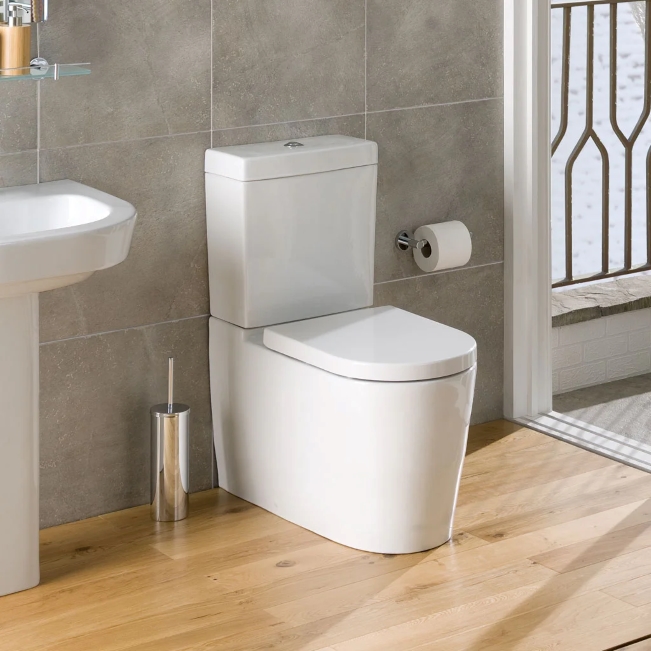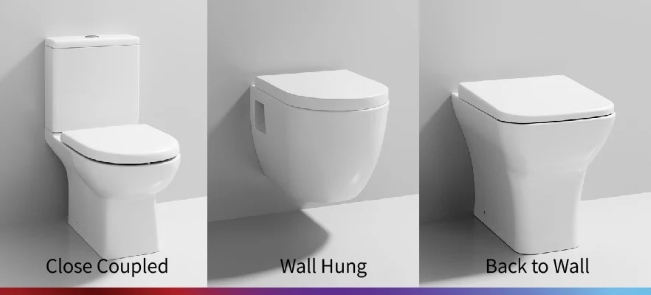In contemporary bathrooms, there’s a growing trend towards creating spaces that offer sophistication and simplicity. A sleek, minimalist look can transform any area, enhancing the overall aesthetic of the bathroom. One of the standout features contributing to a modern bathroom design is the innovative installation method that allows toilets to be concealed within the wall or furniture unit.
This not only creates a clean, streamlined appearance but also maximises space and functionality. As a result, many homeowners have decided to purchase back to wall toilets as they seamlessly integrate into modern interior designs while maintaining a stylish flair.
How Does a Back to Wall Toilet Work?

A back to wall toilet is designed to sit flush against the wall, creating a seamless and sleek look in your bathroom. Here’s a breakdown of how it works.
Installation Design
One major reason why so many people decide to invest in back to wall toilets is their compact design that conceals the cistern (the tank that holds water for flushing) behind the wall or within a furniture unit. This design not only saves space but also provides a clean aesthetic, eliminating the visible plumbing and fittings typically associated with traditional toilets.
Flushing Mechanism
When you press the flush button or handle, the mechanism activates the cistern, which releases water into the toilet bowl. The flushing system can vary depending on the model; it may use a dual-flush option for water efficiency, allowing you to choose between a partial flush for liquid waste and a full flush for solid waste.
Waste Disposal
After the flush, water flows from the cistern into the toilet bowl, helping to wash waste away through the trap (the curved section of the toilet that leads to the drainage system). The back to wall design ensures that the bowl is positioned directly against the wall, which minimises the visibility of plumbing while maintaining effective waste disposal.
Maintenance
Because these toilets conceal the cistern, maintenance is typically more straightforward. However, it’s essential to ensure easy access to the cistern for repairs or adjustments. Some models come with removable panels or access points, allowing for convenient maintenance without having to dismantle the entire unit.
Aesthetic and Space Efficiency
The design of these toilets not only enhances the bathroom’s overall aesthetic but also provides an opportunity to maximise space. By integrating the toilet with other bathroom elements, such as vanities or cabinetry, you can create a cohesive and stylish look while making the most of your bathroom layout. Overall, back-to-wall fixtures combine functionality with modern design, making them a popular choice for contemporary bathrooms.
Comparing Back to Wall Fixtures With Other Toilet Types

Wall Hung Toilets
When comparing back to wall lavatories with wall hung toilets, both designs aim to create a modern, sleek aesthetic in the bathroom. However, they differ significantly in installation and functionality. Wall-hung toilets are mounted directly to the wall, leaving the floor beneath them unobstructed. This design offers the illusion of more space, making it an excellent choice for smaller bathrooms.
The exposed area beneath the toilet allows for easier cleaning, as there are no obstacles on the floor. In terms of installation, wall hung toilets require a more complex setup, as they need a sturdy wall structure to support the weight of the toilet and the user. This can make installation more challenging and sometimes more expensive, as a concealed cistern and mounting frame are necessary.
Back to wall lavatories, on the other hand, are installed against the wall but have a more straightforward installation process since they sit on the floor. They offer a balance of aesthetics and ease of installation, making them a popular choice for many homeowners. Both toilet types allow for efficient use of space and contribute to a modern bathroom look. Ultimately, the choice between a back to wall and a wall hung toilet comes down to personal preference, bathroom size, and the desired aesthetic.
Close Coupled Toilets
Back to wall lavatories and close coupled toilets serve similar functions but differ significantly in design and installation. Close coupled toilets are the most common type found in homes, characterised by a cistern that sits directly on top of the toilet bowl. This design is typically easier to install and more straightforward in terms of plumbing requirements, making it a popular choice for renovations or new builds.
However, these provide a more streamlined and contemporary look. By concealing the cistern behind the wall or within a furniture unit, they eliminate the bulkiness associated with close coupled designs, creating a clean and minimalist aesthetic. This can be particularly advantageous in smaller bathrooms, where maximising space is essential.
Another key difference lies in maintenance. Close coupled toilets often have more visible fittings, which can require more frequent cleaning, whereas back to wall lavatories offer easier access to plumbing components that are concealed. Furthermore, they can be integrated into custom cabinetry or vanities, enhancing storage options and overall bathroom design.
While close-coupled toilets remain practical and reliable, back to wall lavatories present a modern alternative that prioritises design without sacrificing functionality. The choice ultimately depends on individual style preferences and the specific requirements of your bathroom space.
























